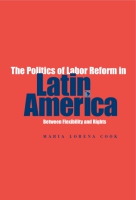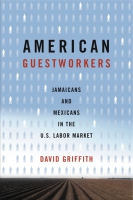
Care Work and Class
Domestic Workers’ Struggle for Equal Rights in Latin America
Merike Blofield
Care Work and Class
Domestic Workers’ Struggle for Equal Rights in Latin America
Merike Blofield
“As Blofield incisively chronicles, until recently, household servants and nannies, who compose 15 percent of the economically active female population in Latin America, were systematically denied basic labor protections. But in country after country, their advocates have improved their lot by making good use of democratic processes.”
- Media
- Description
- Reviews
- Bio
- Table of Contents
- Sample Chapters
- Subjects
Care Work and Class was awarded the 2013 National Women's Studies Association Sara A. Whaley Book Prize.
“As Blofield incisively chronicles, until recently, household servants and nannies, who compose 15 percent of the economically active female population in Latin America, were systematically denied basic labor protections. But in country after country, their advocates have improved their lot by making good use of democratic processes.”
“Blofield offers a powerful corrective to the persistent invisibility of domestic workers—one [of] the most important sectors for female employment in Latin America—in existing labor and Latin American studies. In this empirically-rich study of how and why formally democratic states have recently passed important legislation to protect the labor rights of domestic workers, Blofield also makes a passionate normative case for ending legal discrimination against domestic workers throughout the region.”
“Blofield has created an impressive and comprehensive addition to our understanding of the politics behind recognition, legislative struggles of marginalized workers and contemporary inequality and class in Latin America, when fought for in the legislature, lived out on the street and fully realised in the home.”
“This book explores a long-neglected topic at the intersection of class and gender inequalities in Latin America: the struggle for equal rights by women employed as domestic workers. Merike Blofield dissects the multiple forms of discrimination and exploitation to which female domestic workers are subjected, and she analyzes their efforts—and those of their political allies—to secure legal reforms that recognize basic rights in Bolivia, Chile, Costa Rica, and Uruguay. Her study is a major contribution to the scholarly understanding of the politics of inequality in Latin America, and it is an essential starting point for anyone who wants to understand the potential for change in highly unequal class and gender relations.”
“Merike Blofield’s well-crafted book tackles an understudied yet highly relevant topic, offering a finely nuanced analysis of why domestic workers’ rights are ignored despite decades of democracy in Latin America. Care Work and Class breaks new ground by revealing the conditions under which legal reform occurs, but it also shows when and why laws that protect domestic workers are actually enforced. The book combines empirical richness with careful comparative analysis and is crucial reading for anyone interested in the politics of equality policies in Latin America and beyond.”
“Merike Blofield’s superb study fills an exceptionally large hole in the broader literatures on inequality and gender and politics in Latin America, which have almost entirely ignored domestic workers. Providing both a panoramic overview of the inequalities faced by Latin America’s most exploited class and four rich case studies, Blofield shows the importance of organization from below, frames that resonate, and political opportunities for success in the fight for equal labor rights. This timely study gives us valuable insights into what the future holds for the almost entirely female and ethnically marginalized domestic workers of Latin America and for the politics of care.”
“This book not only contributes to but also helps unite several burgeoning bodies of scholarship, including the literature on gender (and to a lesser degree ethnic) politics in Latin America, the literature on labor law reform and enforcement in Latin America, and the broader literature on social protection regimes in the region. It pays attention to an important population that has rarely been studied (i.e., domestic workers), and it presents a wholly new body of evidence derived from fieldwork in four countries.”
“Overall, [Merike Blofield] does an excellent job of highlighting a significant challenge in Latin America—one that has been overlooked in related literature—while putting it in a regional and historical context.”
“In Care Work and Class, political scientist Merike Blofield examines the systematic exclusion of domestic workers from labor protections across Latin America and the process by which a number of countries have moved toward equal treatment. From the first page, I was immediately drawn into this book and wanted to read more. The introduction and first chapter are brilliantly written, deftly moving between describing the uniqueness of the Latin American context and demonstrating the relevance of this case far beyond the borders of the region, between providing an overview of Latin America as a region and attending to national differences, and between making a compelling argument for the particularities of the case of domestic work and an equally convincing case that there are important insights about a growing range of care occupations to be gained from an examination of domestic service. The first section provides a rich intersectional analysis of the position of domestic workers in the labor market as well as their exclusion from a number of potentially relevant social movements—in particular, movements for women’s rights, indigenous rights, and labor rights. In the second section, Blofield presents detailed case studies of four countries that have achieved full or partial equality for domestic workers. Her conclusion includes insights for care scholars as well as for scholars of social movements who are interested in the central question of the book: in the face of such an overwhelming imbalance of power and resources, when do the interests of domestic workers win over those of their employers?”
Merike Blofield is Associate Professor of Political Science at the University of Miami. Her edited volume The Great Gap: Inequality and the Politics of Redistribution in Latin America was published by Penn State University Press in 2011.
Contents
List of Tables
Preface and Acknowledgments
List of Acronyms
Introduction
1 Domestic Workers in Latin America Toda
2 Overcoming Elite Resistance
3 Working in Chronic Informality
4 Bolivia and Costa Rica: Social Mobilization and Reform from the Bottom Up
5 Uruguay and Chile: Basic Universalism Versus Top-Down Incrementalism
Conclusion
Notes
References
Index
Introduction
This book is about how class and gender interact with the state. It is about whether and how a group that is multiply disadvantaged gets political attention and recognition in a context of high socioeconomic inequalities. Often colloquially referred to as nannies, maids, and housekeepers—or in Spanish as muchachas, nanas, and empleadas—domestic workers come from poorer backgrounds and work in wealthier households. Often also from ethnic or visible minorities, they make up almost 17 percent of the economically active female population in Latin America, or twelve million in absolute numbers, and their services enable the middle and upper classes to work outside the home and to engage in leisure-time activities that they consider more desirable than household work and the daily routine of child care. This dynamic is a by-product of highly unequal societies, which produce a demand for the outsourcing of domestic activities as well as a ready supply of inexpensive labor. Driven not only by class-based views but also by views of the appropriate status for what is traditionally considered “women’s work,” the state has—in Latin America as well as much of the rest of the world—mandated longer work hours and lower benefits for this sector, basically ensuring that the servant is always available, outside of sleep, to serve her employers. This has, in effect, subsidized a cheap labor force for middle- and upper-class families. Recently, these laws have begun, albeit slowly, to change.
The goal of this book is not to make a normative assessment of the desirability of paid domestic work as an occupation per se. What motivates the book, and what I consider politically compelling, is the role of the state in mediating this unequal relationship between the employers and the workers. The legal status of domestic workers exemplifies the tension between equal rights and class divisions and goes to the heart of the debate over what legal equality and social justice in a formal democracy entail. It also exemplifies the status that the state accords the reproductive activities of the household, which are overwhelmingly performed by women and traditionally undervalued. Often, it highlights racial and ethnic divides as well.
These dynamics apply not only to Latin America or to developing countries. Paid domestic work in advanced industrialized countries displays similar characteristics, although the vast majority of domestic workers are immigrants. It is estimated that the sector employs approximately 1.5 million workers across the United States, virtually all of whom are foreign born. Domestic workers in the United States are not covered by federal laws such as the Family and Medical Leave Act, employment discrimination laws, overtime laws, or occupational safety laws. Some states provide additional legal protections—most recently New York State in June 2010 —but many do not. In many other high-income countries as well, immigrant women work as domestics with lower legal protections.
What makes Latin America particularly interesting is that three trends come together: high inequalities, changing gender relations, and democratic politics. First, the region as a whole exhibits the highest income inequalities in the world. This inequality creates both the demand and the domestic supply for the occupation. Although immigration has increased in some of the more developed Latin American countries, the vast majority of domestic workers are nationals of the countries in which they work. While their status as citizens distinguishes the dynamics in this sector from many of the policy debates in advanced industrialized countries, this context of deep domestic inequalities places the workers in a particularly precarious position and makes overcoming collective action problems and competing with elites for political attention more difficult. Second, the significant increase of women in Latin American labor markets has likewise led to the demand for paid domestic work and its supply, explaining the continued prevalence of paid domestic work as an occupation in the region. This interaction of class and gender has led to the ostensible liberation of middle- and upper-class women but has shifted much of the burden not to men but to lower-class women.
Third, the region as a whole, with the exception of Cuba, is formally democratic, providing a context in which discrimination can be openly challenged. Indeed, transitions to democratic politics over the past two to three decades have provided an opportunity to contest explicit discrimination. Across the region, women’s organizations, indigenous movements, labor unions, human rights groups, and others have organized and demanded equal rights and an end to discrimination, and many of the more egregious legal statutes condoning explicit discrimination have been overturned as a result. In many cases, historically disadvantaged groups have succeeded in at least gaining legal recognition and equality, even if proactive enforcement has been slower to come.
What is striking is that two decades after democratic transitions, legal reforms have been so slow to come for domestic workers. Four countries—Colombia, Bolivia, Uruguay, and Costa Rica—have recently equalized the rights of domestic workers with those of other workers (and Argentina may soon become the fifth). However, explicitly discriminatory legal statutes remained in place in fourteen Latin American countries in 2010. In most national labor codes, domestic workers are not granted the same rights as other workers (such as work hours, salary, and benefits), and in some countries the codes even maintain what could be considered feudal clauses (such as mandating the respect of the employee toward the employer but not the other way around). In Brazil, Guatemala, Honduras, Mexico, and Venezuela, domestic workers can be legally obligated to work fourteen hours or more a day, and in many countries, including Argentina and Venezuela, they are legally obligated to behave in a “subordinate” way. In Argentina—and Chile until 1998—they are explicitly excluded from maternity leave, a particularly powerful form of discrimination in an occupation made up overwhelmingly of lower-income women. In addition, enforcement of the rights that do exist is very inadequate, and domestic workers are much more likely than other workers to labor informally, without written contracts or social security. Hence, domestic workers suffer from a double discrimination: explicit legal discrimination and a lack of proactive enforcement of rights that do exist.
It is not substantive irrelevance that keeps this discrimination on the books. Even though some scholars predicted the demise of domestic service as an occupation with economic modernization, paid domestic work today shows no clear signs of decline. As noted above, the occupation employs almost 17 percent of the economically active female population in Latin America and is hence the largest single source of employment for women. Concomitantly, about 15 percent of households in the region employ one or more full-time domestic workers. Thus, not counting households that employ part-time domestic workers, about 30 percent of all households in the region are intimately part of this economic exchange, either as employers or as workers.
Neither are the extant statutes due to simple oversight. In fact, when these laws have been contested, there has been considerable resistance among political elites to overturn them, as the status quo is natural to many of them and in their interests. This resistance is more than economic, however. It is also cultural; with this group, perhaps more starkly than with any other, race, gender, and class prejudices and discrimination are crystallized. After years of efforts, the International Labour Organization (ILO) passed an international convention on domestic workers’ rights in 2011. This book addresses the politics of domestic workers’ rights prior to the convention, and the conclusion discusses the approval of the convention and the implications in Latin American countries.
There are a variety of conceptual lenses through which to examine the dynamics of paid domestic work. First, a central question of this book is whether and how the political system addresses the demands of people who are socioeconomically most disadvantaged. However, the book is not just about “the poor” but also about the middle classes and the rich, and how the well-off see the world and their place in it. Legally and economically, the interests of domestic workers are opposed to the interests of their employers, who belong to the middle and upper classes. How the state mediates this power relation—in terms of both laws and enforcement—is an indicator of how the state balances the interests of the rich versus the poor in a democracy.
Second, paid domestic work is also one component of the politics of care work and gender relations in contemporary societies. With urbanization and a shift to service sector economies, more women have entered the paid labor force and more families have sought to resolve their child care needs without full-time homemakers. This has specific gender and class implications in Latin America. On the one hand, care work—both paid and unpaid—is still predominantly performed by women. On the other hand, the options available to poor families versus middle- and upper-class families are very different. In Latin America, wealthier families can afford private domestic workers, given the ready supply of cheap labor, while lower-income mothers leave their own children in informal care arrangements to work as nannies and maids themselves. Given the legal restrictions on employees in this sector, the state in effect provides a subsidy to the wealthy by allowing for a cheap labor force with extended work hours and few benefits. This has most likely also reduced middle-class demand for child care and elderly care centers, which are the dominant mode of resolving dependent care needs in advanced industrialized countries.
Third, and relatedly, the politics surrounding this sector are not only about class and economic interests or about gender and the politics of care work; this is very much a case of the intersectionality of class, gender, and race or ethnicity. Domestic workers are overwhelmingly women and from poor backgrounds; they also tend to come from ethnic or racial minorities. Female domestic workers earn on average less than male domestic workers, and domestic workers from ethnic or racial minorities tend to earn less than white domestic workers, indicating that the low pay in domestic service is not only a function of the occupation per se. Finally, in some countries, many domestic workers are noncitizens. These multiple disadvantages place domestic workers in a particularly precarious and powerless position vis-à-vis society as a whole and even vis-à-vis potential advocacy coalitions (Strolovitch 2006). While domestic workers are women, laborers, and often from ethnic minorities, their needs have tended to remain invisible within labor unions, women’s organizations, and indigenous movements. Indeed, Laurel Weldon (2008) recently stated that an excellent case study for intersectional analysis is that of paid domestic workers.
Despite their substantive and theoretical importance, domestic workers have received surprisingly little attention in the scholarly literature to date. In 1989, Elsa Chaney and Mary Garcia Castro published a seminal edited volume on domestic workers in Latin America entitled Muchachas No More: Household Workers in Latin America and the Caribbean. In the introduction, they declared that “the scant attention paid to this important sector of working women is surprising” (3) and called for further research. While several excellent historical and anthropological works have since been published, the call has gone largely unanswered for studies from a sociopolitical perspective. This book seeks to fill this gap by examining domestic workers from a specifically political and comparative perspective.
In chapter 1, I compare the politics of care work in advanced industrialized countries and Latin America, where inequalities are much higher. Paid domestic work is one component within the broader context of care work and gender relations, and its prevalence is also a function of the level of socioeconomic inequalities both domestically and globally. Within this context, paid domestic work embodies some unique characteristics, which I discuss, drawing on the extant literature. I then discuss the history of domestic service in Latin America and move on to describe domestic service in Latin America today, the prevalence of this form of employment, and the laws that surround it.
In chapter 2, I address the central question of the book: whether and how the political system addresses the interests of groups that are multiply disadvantaged. Domestic workers exemplify such a group, as their specific shared identity is through the nature of their labor, which is poorly remunerated; in addition, virtually all are women and many are from ethnic or visible minorities that have been historically underrepresented and discriminated against. While domestic workers’ organizations have demanded social attention and equal labor rights in many countries for decades, political actors in the region have been extremely reluctant to respond to their demands, given that increasing the position and rights of domestic workers involves some form of redistribution and that such changes conflict with the interests of political elites themselves and their better-organized middle- and upper-class constituents. The traditional undervaluation of household and care work, performed by women, also plays a role, and, finally, racism among some elites may make them less likely to view domestic workers who are darker skinned or from different ethnic groups as their social equals and deserving of the same rights. Resistance to extending rights—whether in the form of active opposition or indifference—is likely to be broad and steadfast, and most political elites will tend to either ignore such concerns or table legislative bills addressing them. Even ostensible allies such as feminists and labor unions are likely to focus on the interests of their more advantaged, organized members first (Strolovitch 2006).
Despite the weak position of domestic workers, however, there are instances of successful policy reform. Out of eighteen major Latin American countries, eight have substantially reformed domestic worker laws since democratization and as of 2010. Of these, four have achieved virtually equal rights (Bolivia, Colombia, Costa Rica, and Uruguay) and four have to date enacted partial reforms (Argentina, Brazil, Chile, and Peru). I outline these reforms as well as reform attempts in countries where the attempts have not been successful. I then ask the question, how does equal rights reform make it onto the political agenda and get passed, and when it does not, why? Phrased another way, when do domestic workers’ interests win over those of their more powerful employers?
While elite resistance to change can explain much of the overall lack of reform in the region, I argue that mobilization by domestic workers’ organizations, a network of allies, and political “windows of opportunity,” mostly linked to left-wing executive and legislative allies, can result in legal reform even in a region as unequal as Latin America. There is no single path to reform; smaller, piecemeal reforms require less mobilization and pressure than equal rights reform that includes work hours. The key struggle has been to make the issue visible and to get it onto the political agenda; once the issue gets to a plenary debate and goes up for a vote, it is very likely to be approved. With executive support, which to date has rarely been forthcoming, agenda setting and reform can be speedier and less obstacle ridden.
The enforcement of laws is, of course, as crucial an issue as are the laws themselves. Many of the legal rights of domestic workers—whatever they are—are not respected in practice. In chapter 3, I address enforcement and discuss two specific dimensions of it: access to social security protections and the prevalence of labor violations. I then discuss the key factors that explain variance in enforcement across the region. On implementation and enforcement, state capacity and executive ideology—particularly in the ministry of labor—are crucial.
In order to illustrate these dynamics, I process-trace the politics of legal reform and enforcement of domestic workers’ rights in four countries: Bolivia, Costa Rica, Uruguay, and Chile. All four are unitary countries—making comparative analysis more feasible—and at the time of choosing the case studies, the four countries spanned the range of outcomes: full reform in Bolivia in 2003 and in Uruguay in 2006, partial reforms in Chile, and no reform in Costa Rica. Since then, in 2009, Costa Rica passed equal rights reform. However, the process of reform in that country remains illustrative of the political dynamics associated with domestic workers’ rights.
This case selection also represents a pairing of “most-different” cases and “most-similar” cases (see table 2.3). With significant economic, sociodemographic, and political differences, Bolivia and Costa Rica are most-different countries with a similar outcome: equal rights reform. Uruguay and Chile, with more developed economies and more institutionalized democracies, are, on the other hand, most-similar countries with different outcomes: equal rights reform in the former and piecemeal reforms but not equal rights in the latter.
In chapter 4, I discuss Bolivia and Costa Rica, where the political process was long, arduous, and obstacle ridden. In Bolivia, the first country to achieve equal rights through Congress, the initial legislative bill to equalize rights was submitted in 1993. A revised version was approved in the House in 2000 and finally in the Senate in 2003. In Costa Rica, the initial reform bill was submitted in 1996, and after several attempts another bill made it through commission in 2003 and was finally brought to a legislative vote at the end of 2008, was approved, and became law in 2009. In both countries, reforms were the result of extensive mobilization and pressure from domestic workers’ organizations and, over time, their social and political allies. The executive in neither country proactively supported reform, forcing advocates to go through slower legislative channels. There, resistance by political elites kept the bills from an open debate and vote for years, but finally advocates were able to take advantage of political windows of opportunity when they arose. On the other hand, in both countries but especially in Bolivia, enforcement efforts have lagged.
In chapter 5, I discuss Uruguay and Chile. In Uruguay, a legislative bill to equalize domestic workers’ rights was submitted to Congress in 1990, and after a long wait it was approved in a plenary vote in the House in 1996. It was repeatedly postponed in the Senate and died in commission. In 2005, the newly elected left-wing government initiated equal rights reform, which was rapidly approved in 2006. In Chile, four piecemeal reforms over the past two decades, three of which were tagged onto broader labor reforms, have incrementally provided domestic workers with more labor rights (severance pay, maternity leave, minimum wage, and equal holidays). However, their legal workweek still remains significantly longer at seventy-two hours, compared to forty-five hours for wageworkers in general. While in both countries reforms were led by political elites, the differences between their reforms are reflective of more general political differences: Chile’s narrower reforms were top-down, in the context of weak mobilization and strong conservative opposition, while Uruguay’s comprehensive equal rights reform reflected the participatory, inclusive nature of the left-wing government (Pribble 2011). On the other hand, left or center-left governments in both countries have spearheaded improved enforcement efforts.
In the conclusion, I tie together the political dynamics that have characterized reform attempts toward this sector. I then discuss the process that led to the approval of the ILO convention on domestic workers’ rights in June 2011 (as this book went to press) and its potential impact on the visibility of and agenda setting on this sector in the future. With the support of the ILO, advocates have received a boost in their reform efforts, and there may come a tipping point at which political elites decide that the political benefits of reform outweigh the costs. I draw on the current legal reform under consideration in Argentina—where the Chamber unanimously approved equal rights in March 2011 and where the bill now awaits Senate debate—to illustrate these changing dynamics. I then contrast domestic workers’ rights with other claims to equal rights, highlighting the similarities and differences with other women’s rights or gender equality issues, as well as with informal sector workers. Finally, I return to a broader discussion of the future of care work in Latin America and make some empirical predictions and normative policy recommendations.
Also of Interest
Mailing List
Subscribe to our mailing list and be notified about new titles, journals and catalogs.






